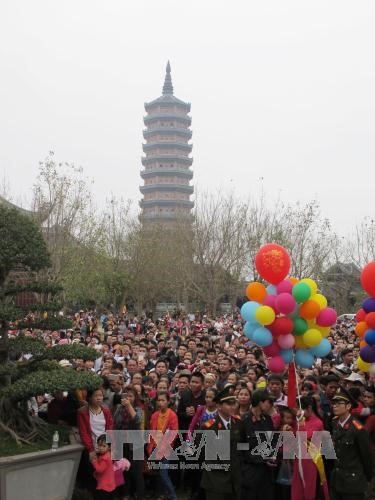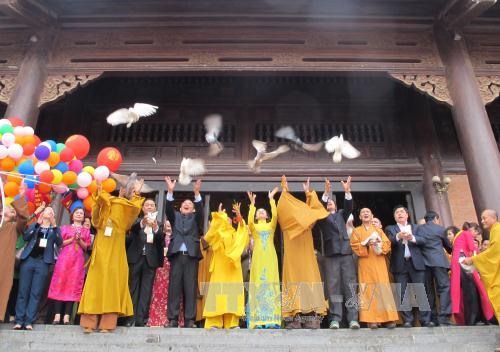 Life & Style
Life & Style

The opening ceremony of 2017 Bái Đính pagoda Festival was held on Thursday, the sixth day of the first lunar month, in northern province of Ninh Bình. The annual festival will remain open until the third lunar month of this year.
 |
| Thousand of visitors and Buddhism followers attended the event, which is held annually. |
NINH BÌNH — The opening ceremony of 2017 Bái Đính Pagoda Festival was held on Thursday, the sixth day of the first lunar month, in northern province of Ninh Bình. The annual festival will remain open until the third lunar month of this year.
Deputy Prime Minister Trương Hòa Bình and Secretary of Ninh Bình provincial Party Committee, Nguyễn Thị Thanh, representatives of Việt Nam Buddhist Sangha and thousands of Buddhism followers and visitors all participated in the event.
The old Bái Đính Pagoda was built thousand years ago and is one of the famous destinations of Ninh Bình Province, former capital of Việt Nam," said monk Thích Thanh Nhiễu of Bái Đính pagoda.
“Experiencing the ups and downs of history, the pagoda has been greatly valued and preserved by Buddhist followers and local people,” said monk Thích Thanh Nhiễu.
To tap into the cultural and moral value of Buddhism, the old Bái Đính Pagoda was expanded with new rooms being constructed. The current Bái Đính Pagoda has become a symbol of cultural and moral value as well as a religious centre for Buddhism followers, he added.
Bái Đính Pagoda is included in the Tràng An Landscape Complex, which is recognised as World Cultural and Natural Heritage by UNESCO. The province expects to host more visitors to its Bái Đính pagoda and other landscapes in the upcoming years, said Secretary of Ninh Bình provincial Party Committee Nguyễn Thị Thanh.
This is the third time the festival has been held since Tràng An Landscape Complex was recognised by UNESCO in 2014.
The new Bái Đính Pagoda, also known as Bái Đính Buddhism Spiritual Centre, covers 700ha, and is the largest in Việt Nam in terms of size. "Bái Đính" means "the worship of heaven and earth, Buddha and celestial angels."
The 1977th anniversary of Hai Bà Trưng Uprising was held and Hai Bà Trưng Temple Festival opened in Mê Linh District, Hà Nội city on Thursday with the participation of Vice President Đặng Thị Ngọc Thịnh, former Vice President Nguyễn Thị Doan, state and city leaders and local people.
Hai Bà Trưng (Trưng sisters) were two women, Trưng Trắc and Trưng Nhị, who made a victory in a battle against Chinese Hán invaders in AD 40.
Also on Thursday, a nêu pole lowering ceremony was held in Thế Miếu Shrine, Huế, former imperial citadel. The ceremony is to remind people to resume work after the holiday. Nêu pole was lowered with its root being taken from the ground. The seal which had been hanging from the top of the pole was also taken down.
Director of Huế Monuments Conservation Centre Phan Thanh Hải said one of the things that locals anticipated the most was the moment the seal was taken down and stamped in paper with words like blessing and happiness. It is believed to bring good things to the recipients, said Hải.
Traditionally, the erecting of the Nêu Pole signified the break of the Royal Court’s activities for the New Year Holiday. The Emperor would order the Royal Seal, Sword and Pen to be hung till proceedings resumed. The meaning behind this ceremony was to prevent evil and stop demons. All of these allowed the Vietnamese people to enter the new year with a fresh start and a happy mind. Citizens would only begin their New Year celebrations after the Nêu Pole was erected.
In Bắc Giang Province, the 590th anniversary of Xương Giang victory was also held and with the launch of Xương Giang Temple. The event is to pay respect and commemoration to king Lê Lợi, soldiers and Xương Giang people who fought and sacrificed in this proud land.
This festival is built on the basis of Chi Lăng – Xương Giang victory in 1427 of Đại Việt (former name of Việt Nam) people against nearly 10 ten thousand Minh enemy.
The festival in Bắc Giang also featured quan họ (love duets) singing, ritual mediumship performance and a demonstration of rural market. —VNS
 |
| Festival goers including Deputy Prime Minister Trương Hòa Bình released birds in the festival. —VNA/VNS Photos Đức Phương |




